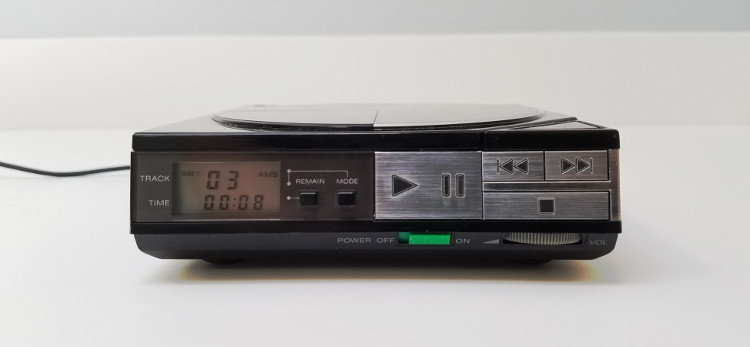
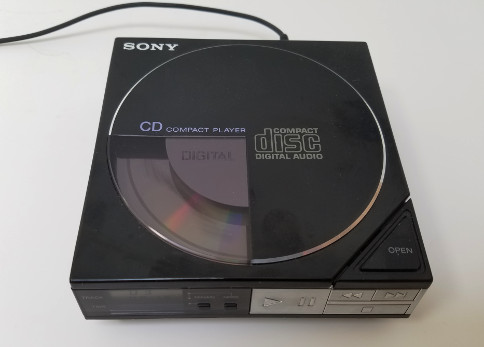
It's not a radio, but it is an important milestone for portable audio devices.
The Sony Discman D-5, first released in late 1984 but marketed most widely in 1985, was the first portable CD player. For its time, it was quite an accomplishment.
The Compact Disc itself was first demonstrated by Sony and Philips in 1979, with the first commercially available CD player released by Sony in 1982 but not, at first, in the United States. It wasn't until 1983 that the Sony CD player was available in the U.S. Compact discs were scarce, produced either in Germany or Japan, but nowhere else until the mid-1980s.
Even so, the CD represented a quantum leap in performance: better dynamic range, almost no noise, frequency response well beyond the range of human hearing, and durability. No more surface noises, pops, or crackles that often plagued long-playing (LP) 12" records.
Shortly after Sony introduced its player, many of the other big players in high-fidelity equipment, such as Kenwood, Technics, and Yamaha, as well as the North American branch of Philips (Magnavox), introduced their own players. In its July 1983 issue, Stereo Review compared 11 players. Even with the competition, CD players were expensive. Most of the players in the Stereo Review report cost $1,000, equivalent to $2,575 in 2020. The Sony player was a relative bargain at $900, or $2,316 in 2020 dollars.
In 1983, between the scarcity and expense of CDs, and the high price of CD players, the CD's ability to compete with LPs was in some doubt. Sony got to work to see if it could get the price of players down could make a less expensive player. Sony executives also wanted a portable player to complement its burgeoning line of Walkman cassette players and radios.
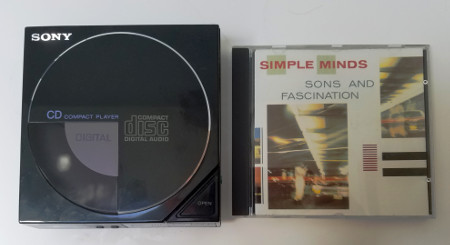
Reportedly, Sony designers and engineers were told to make sure the new player would be no taller as four CDs stacked atop one another. Late in 1984, the D-5 was revealed, and it was just a little taller than three jewel cases, with the width and depth being very close to the size of a jewel case.
The engineers got the price down, too: $300, one-third the price of the pioneering CDP-101 player from more than a year before. In 2020, the equivalent cost would be $714.
The D-5 featured several innovative designs. Articles in the December 1984 issue of Stereo Review and the February 1985 issue of Audio explained that most of the digital-audio functions of the player had been put on one custom VLSI (very large-scale integrated-circuit) chip, including some functions besides those required to decode the audio stored on the disc. The laser-powered optical scanning system had also been miniaturized substantially. To reduce the power required by the unit, the display showing the CD track number and time elapsed used a liquid-crystal (LCD) display rather than a light-emitting diode (LED) display, which was far more common at the time.
While clever and innovative design definitely helped strike a balance between portability and price, some compromises were required, particularly for the D-5's power supply.
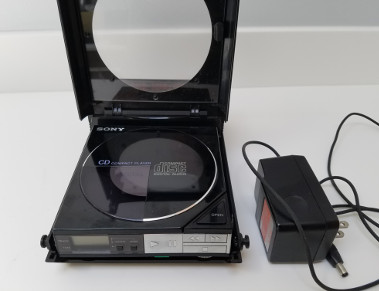
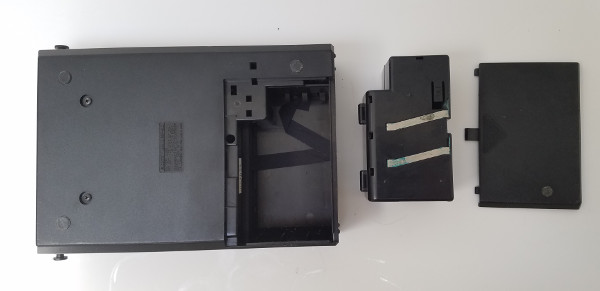
As a result, the D-5 did not have a built-in power supply. A very large AC adapter (left, above) was required to power the unit. For portable use -- and I use the word portable somewhat loosely -- a separate case and battery pack were required (also shown above along with the door to the battery compartment). For battery power, the D-5 required six C cells, or an optional rechargeable nickel-cadmium pack.
The case and battery pack were also optional, costing an extra $50 ($120 in 2020 dollars). The case does a good job of protecting the player, and also enables recharging of nickel-cadmium batteries. There were no metal-hydride or lithium-ion batteries in those days; a lithium-ion battery probably would have enabled further reductions in size and weight.
Power consumption of five hours of battery life with regular alkaline cells was supecified. The reality, in my experience, was somewhat different. I usually managed to get a little more than an hour from battery operation. If the nickel-cadmium batteries were used, battery life was specified at two hours.
I bought my D-5 in May 1985 in Houston, and bought the battery pack and case along with it. My thought was that I could use the Discman in my car on long trips. Strangely, even though a power cord for 12-volt operation in a car was available, I chose not to buy one!
That may have been just as well. I remember a trip to Missouri from Houston along US 59 in deep-east Texas where every bump in the road caused the player to skip. There was no buffering in the D-5, nor any form of mechanical shock absorption. For home use, that wasn't a problem, but in a more dynamic environment such as a car, I found that the Discman wasn't all that suitable.
The D-5 clearly was intended for multiple environments, including use in a home stereo system. After all, it was two-thirds less expensive than previously available players.
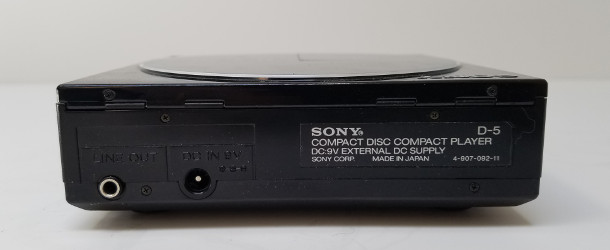
Sony understood that. Unlike just about any other portable audio device, the D-5 featured a line-out jack in the rear (left) and included a patch cord with two "RCA"-style plugs, standard in many stereo systems even to this day. The clear intent was for the player to be plugged into a home stereo system using the patch cord. The line-level output was at a fixed level suitable for use in a home stereo system. By the way, I lost my patch cord for the D-5 a long time ago, but replacements were easily available.
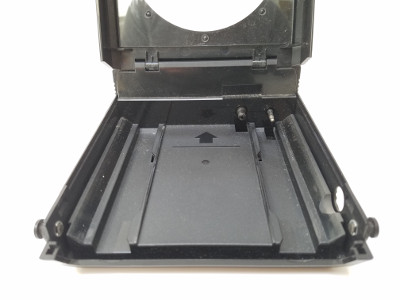
Even the optional carrying case made provisions for the line-level output. In the picture at right, you can see a couple of plugs sticking out of the rear of the empty case. You would slide the D-5 into the case and seat the plugs into their respective jacks. Everything lined up beautifully. Those plugs were wired to jacks on the right side of the case, where the line-out and power-adapter connections could be used whenever the Discman was in its case.
There was also a standard headphone jack for use with headphones, mounted on the right side of the Discman. Headphones did not come with the unit, but were optional. Both the line-level output jack and the headphone jack accommodated 3.5mm stereo plugs. An angled headphone plug may be difficult to use with the player in the case, however. An extender or other adapter may be needed.
For its time, there was a lot packed into this little unit for $300. Functions, though, were basic. You could either advance track by track (AMS mode) or fast-forward or rewind through an individual track (search mode). Search mode maintained the proper pitch of the record track even at faster speeds. The track display could also be repurposed to show the number of tracks and the time remaining by holding down the REMAIN button. There was a volume control, but no tone control. That was about it as far as features went. No shuffle play or other programming functions were available. Nor was there a remote control. While a high-quality product, given the technology of the time, the small size of the unit probably limited the functions that could be built into the product.

Even with those limitations, the D-5 was a high-performing player. The December 1984 issue of Stereo Review featured an in-depth review of the Discman. It was far better than the CDP-101 component player to continue playing a compact disc even if it had slight defects. The D-5's frequency response was 20-20,000 Hertz, wider than the range of human hearing. Distortion was specified as being less than 0.008 percent.
The D-5 was clearly an important product. The previous year, Billboard had hired a columnist to focus specifically on developments relating to compact discs. That columnist, Sam Sutherland, in the January 12, 1985 issue of Billboard, referred to the D-5 as a "bellwether".
It's hard to determine how long the D-5 (or the D-50, as it was designated for the Japanese market) was in production. For sure, at least through 1985. It was listed in Stereo Review's Stereo Buyers' Guide 1986, published toward the end of 1985. By the time Stereo Review Presents: Compact Disc Buyer's Guide 1987 was published in late 1986, Sony had multiple portable models. The D-5 had become the D-5SPL, listed at $270 including the battery pack and case. Also available at slightly higher prices were the D-7, which was programmable; the D-55, with an FM tuner; and the D-77, with an AM/FM tuner. Aside from the buyers' guides, the hi-fi magazines of the time didn't take notice of these models.
In April, 1987, the D-10 was released, advertised and promoted in hi-fi publications. It included more programming capabilities, an optional remote control, a built-in rechargeable battery, and lower power consumption for improved battery life. However, its audio specifications were practically identical to the earlier D-5, indicating that improvements in successive models would center on features and battery capacity. The D-10's list price was $350 ($790 in 2020 dollars).
How does the D-5 stack up today? My hearing certainly isn't what it was in 1985, but I can say that the original Discman still sounds really good. The volume control isn't noisy. Mechanically, the unit is in great shape. There's a minor hitch with the door on the top of the unit but it goes away after being used a few times. It looks good, having been protected by that case for all those years.
I have encountered difficulties with a few CDs, which either have distorted sound, or no sound at all, when played through the D-5. They are fine with other CD players. I don't have an explanation for this, and I have found this problem with only two CDs out of my collection of around 800 CDs.
The D-5 even plays 3-inch CDs (or CD-3s), smaller than the original standard CDs, even though that format was developed after the D-5 was designed and sold. No adapter is needed.
It was fun to rediscover the Discman after it had been sitting in a storage room unused for more than a decade. Despite being idle for so long, it started right up again. While not rich in features, it does the basics well, looks good, and performs very well. It's a good deskside companion for when I want better sound quality than I get when listening to compressed media files or overprocessed FM radio.